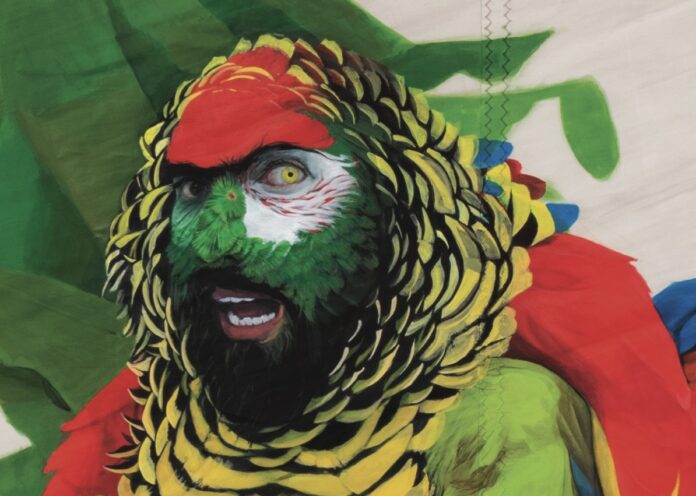Visibility is just out of reach in Have You Seen Me? (through March 29 at San Francisco State University’s Fine Arts Gallery). The exhibition, thoughtfully curated by Sharon E. Bliss and Kevin B. Chen, showcases work by Marcel Pardo Ariza, Erica Deeman, Yaron Michael Hakim, and Jamil Hellu, and explores the limitations and opportunities within representation. In doing so, these artists challenge the viewer to reflect on their gaze and subsequent assumptions to untangle the ways in which we look at one another. At the same time, the exhibition also makes evident the idea that self-definition is in a constant state of flux—an ever-evolving status subject to time passing.
Is it possible to truly “see” someone else? Painting, sculpture, installation, and photographic work by the artists unpack this question of subjectivity through self-portraiture—cleverly extending this query to perhaps one’s own (in)ability to see oneself clearly, and the ramifications of visibility in general.

Erica Deeman’s work on view is from her 2020 series Familiar Stranger consisting of eight double-fired 3D printed clay models of her face. Through the experience of firing, each piece takes on a different likeness of the artist. Upon closer inspection, one can see in detail the peaks and valleys where the printer mapped the landscape of her features and the chaotic intervention of heat. Not only does this piece challenge precision of technology to represent an image, but it also conjures how one visualizes someone they’ve seen in their mind—rather than a still frame, one imagines a composite of many momentary glances.

Similarly, In Jamil Hellu’s 2016-17 Hides series, the artist challenges screenprinting’s ability to create infinite copies of an image by printing his portrait on lambskin, which will inevitably decompose. However, in addition to creating this material paradox, Hellu also signals the gravity and sometimes violent impact of one’s gaze. Nine lambskin portraits hang from the gallery ceiling in a stair-stepped arrangement. Hellu’s image in a keffiyeh is printed on the fleshed side of the leather and draped such that the skin resembles a figure hunched forward in a protective posture. Ephemeral and powerful, the installation evokes the specters of subjectivity, elusive and flexible, to disrupt the foundation of stereotypical caricatures of this type of dress by showing the dynamic ways of the keffiyeh can be worn.
Yaron Michael Hakim’s work parallels the concept of dynamic cultural understanding in his self-portraits as hybrid human-bird figures painted onto fragments of sailing cloth, taking inspiration from South American macaws. The raw edges of the fabric invite the viewer to imagine the edges of the painting as unfinished. At the same time, the reference to sailing alludes to a legacy of cultural exchange and colonialism. The stitching holds segments of the painting together while representing the artist-as-bird in a forest, camouflaged among the foliage.

Another of Hakim’s pieces, Untitled, creates a commentary on the legacy of colonialism as it relates to a marker of identity: one’s name. Hakim’s birth name (Santiago Rojas) and the Hebrew name given to him when he was adopted are etched onto either side of a machete in Latin, his name filtered through the lens of European conquest. The knife hangs from the gallery’s ceiling, both alluring and imposing, suggesting the (im)possibility of reconciling the duality in his identity. Yet, the knife holds both of these names on its surface, a physically bound binary, mapping the complex histories that came before him.
In Marcel Pardo Ariza’s Fiera and Marcel encarnándose, the artist poses with collaborator and companion, Fiera Ferrari, wrapped in a luscious orange gauze fabric. In the triptych, Ferrari and Ariza break and maintain eye contact with looks of vulnerability and power. Each photograph is tilted at a 45-degree angle with a detailed shot of the orange fabric beneath. At this close-up vantage, the viewer can make out the interlocking warp and weft of the fabric’s surface. By drawing a parallel between the construction of textiles and the embracing pose, the work suggests the artist and Ferrari’s close and interdependent relationship. Further, it reveals the network of community members that inform one’s self-definition.

Through the tactics of material choices, conceptual rigor, and the pose, these artists embrace instability in identity, opting to bask in the liminal spaces between seeing and being seen while asking the viewer to reconsider stagnant perceptions of the other in favor of seeing one another in a state of becoming.
Help us save local journalism!
Every tax-deductible donation helps us grow to cover the issues that mean the most to our community. Become a 48 Hills Hero and support the only daily progressive news source in the Bay Area.
HAVE YOU SEEN ME? runs through March 29 at San Francisco State University’s Fine Arts Gallery. More info here.





